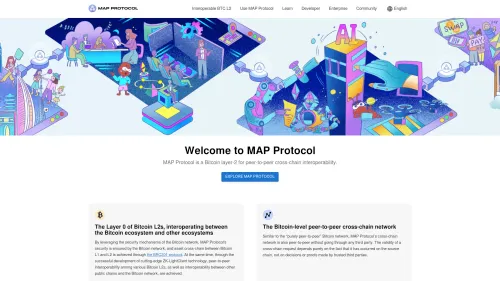MAP Protocol (MAPO)
MAP Protocol is an open, decentralized chain-to-chain interoperation protocol that facilitates the interoperability of independently verifiable consensus blockchains without the need for a relay chain. This protocol provides a robust foundation for diverse applications, including decentralized finance, exchanges, IoT, AI, and governance. Utilizing cross-chain shared storage, communication, and privacy computation, MAP Protocol supports various advanced technological fields.
Overview
MAP Protocol is a relayer-free chain interoperation bridge protocol rooted in the Polkadot ecosystem. It achieves real-time chain interoperability with logarithmic space complexity through cryptographic confirmation. The MAP Bridge, designed based on MAP Protocol, receives funding from the Polkadot Web3 Foundation. The core modules of MAP Protocol include the MAP Feeder for cross-chain writing, the Ultra-Light Verification Protocol (ULVP) for cross-chain reading, and the MAP Standardized P2P Stack for P2P node discovery and data transfer.
Features of MAP

| Ticker | MAPO |
| Category | Protocol |
| Website | https://www.mapprotocol.io/ |
| @MapProtocol | |
| Telegram | MAPprotocol |
| https://www.reddit.com/r/MarcoPoloProtocol/ | |
| Contract Addresses | |
|---|---|
| map-protocol | mapo |
| binance-smart-chain | 0x66...99 Copied! Copied! |
| ethereum | 0x66...99 Copied! Copied! |
MAP Protocol offers several noteworthy features:
- It allows one blockchain to validate the state of another with minimal storage and bandwidth requirements.
- It enables one chain to modify the state of another with appropriate authority.
- MAP serves as a block transportation channel based on IBLT, which helps compress block sizes during relays.
- The protocol provides an improvement framework for developers to create interoperable blockchains.
- It facilitates peer discovery and data streaming across different blockchain systems.
MAP token distribution
MAP Protocol initially issued 10 billion tokens with a structured distribution plan. Incentives for the founding team are partially locked for five years, with no unlocking during the first two years. Subsequent unlocks occur annually each January, with market circulation managed according to actual expenditures. Incentives for the main team follow a similar lock schedule, with releases every six months starting in 2021. Core team allocations, application ecosystem, and PoB community incentives are unlocked annually, while partner and institution portions depend on specific conditions.
Tokenomics
The MAP Protocol has a circulating supply of 318,474,889 MAP and a total supply of 10,000,000,000 MAP, ensuring a structured and planned distribution.
Awards
MAP Protocol received recognition by winning the Most Valuable Award at the 2020 Ethereum Hackathon.
Exchanges
MAP Protocol is accessible on several exchanges, including Bithumb, KuCoin, and Coinone.
ICO
No initial coin offerings were conducted for MAP Protocol; instead, tokens are listed directly on exchanges.
Partnership with Litentry
MAP Protocol has partnered with Litentry, a cross-chain identity aggregation protocol. Litentry will provide identity services to MAP Protocol, integrating cross-chain identity data and supporting account association and identity management. MAP Protocol will act as a data provider within the Litentry network. This collaboration explores further integration to enable developers to utilize the MAP Protocol cross-chain protocol for enhanced interoperability.
Partnership with Darwinia
MAP Protocol collaborates with Darwinia to standardize bridge chains and address issues related to state verification and transaction formats when bridging with other chains, particularly those based on the substrate chain. This cooperation aims to enhance network interoperability, which is crucial for the widespread adoption of blockchain technology. Darwinia Network, a decentralized bridging network, is known as the Golden Gate Bridge of cross-chain ecology, facilitating connections within the blockchain ecosystem.
